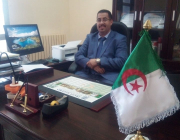Yahyaoui Habibi, Sami Guellouh AFRB.
ANALYSIS OF SOCIAL RESILIENCE TO THE NOVEL CORONAVIRUS (COVID-19) IN ALGERIA. Geomatics, Landmanagement and Landscape [Internet]. 2020;2020 (3) :19–29.
Publisher's VersionAbstractThis paper is an attempt to understand and overcome the peculiarity of the novel Coronavirus (Covid-19), described as a pandemic by the World Health Organization. Covid-19 is spreading around the world, and particularly in Algeria, which announced the identification of the first case on the 26 February 2020. The number of confirmed cases is increasing day by day. Currently, we experience the spread of the word “resilience” in most diverse research areas and policy fields of modern society. Social resilience is the capacity of a social entity to proactively adapt to and recover from disturbances that are perceived within the social entity to fall outside the range of normal; this includes expected and unexpected disturbances. The main objective of this study is to contribute towards connecting the socio-economic vectors of this pandemic, and to integrate them into the GIS (Geographic Information System), in order to analyze the level of social resilience in Algeria. The analysis adopted the method known as the Hierarchical multi-criteria analysis (AHP), which defines the relative importance of each characteristics. The findings of our research show that the factors of high unemployment and housing occupancy rates, high population density and the share of citizens aged over 60 directly influence the reduction in the level of social resilience to the novel coronavirus.
 gll-3-2-2020.pdf
gll-3-2-2020.pdf MULTI-CRITERIA METHOD (WLC) AND GIS MODELING TO ANALYZE SOIL EROSION VULNERABILITY IN CONSTANTINE CITY (ALGERIA). Annals of the University of Oradea - Geography Series [Internet]. 2020;2 (2020) :141-146.
Publisher's VersionAbstractLand degradation due to soil erosion constitutes a serious threat in the Mediterranean regions, and particularly in Algeria. The objective of this study is to characterized the vulnerability to soil erosion in Constantine city (county seat of the Wilaya of the same name) using a spatial multi-criteria method. The followed approach focused on interaction of several factors (climate, topography, lithology and land cover) Acting erosive process by means of Weighted Linear Combination (WLC) that facilitated the quantification of the global effect of these factors in fine and objective manner. The results show that more than 50% of the city’s surface is exposed to high vulnerability, which requires the implementation of soil erosion control measures.
 auog.302103-811.pdf
auog.302103-811.pdf Guellouh Sami, Kalla Mahdi FAHY.
SITE SELECTION FOR FUTURE INDUSTRIAL INFRASTRUCTURE IN THE PROVINCE OF CONSTANTINE (ALGERIA). Geomatics, Landmanagement and Landscape [Internet]. 2020;1 (2020) :23-32.
Publisher's VersionAbstractThe aim of this study is to select the appropriate sites for the designation of future industrial zones in the province of Constantine, Algeria, using a geographic information system (GIS) and Remote Sensing, including the appropriate technical and environmental requirements.
The identification of appropriate sites for the establishment of new industrial zones in alignment with a planning process based on a set of socio-economic and environmental information and instructions has become a key problem for planners.
The factors involved in the selection of sites are classified into two categories (exclusion factors and appreciation factors) to be able to identify the most appropriate areas for future industrial facilities in the province in question.
 gll-1-2-2020.pdf
gll-1-2-2020.pdf 